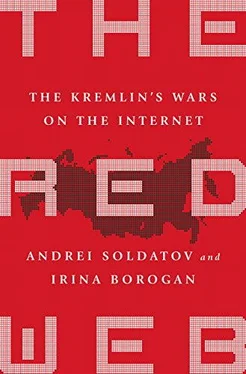The visionary behind the programming team was Valery Bardin, thirty-one years old, who was frequently overwhelmed by great and sometimes odd ideas, some of them truly brilliant. [5] Bardin, interview with authors, August 2014; and recollections of Demos employees published at http://news.demos.su/private/demos.html .
When Soldatov heard about the adaptation of Unix and Bardin’s band of programmers, he recalled how a network connected computers at the Niels Bohr Institute. Soldatov then proposed building a computer network, based on Unix, at the Kurchatov Institute. [6] Alexey Soldatov and Valery Bardin, interviews with authors, August–October 2014.
Over the next four years programmers from Kurchatov built a Russian version of Unix and applied it to a network. [7] The programmers from Kurchatov Institute worked in conjuction with colleagues at the Ministry of Car Manufacturing.
It was named Demos, an acronym for the Russian words meaning “dialogue united mobile operating system,” and the team was rewarded with a prize from the Soviet Council of Ministers. The prize, however, was classified as secret. The local Kurchatov network was created on some of the same protocols the Internet is built on today. While Bardin’s programmers brought their brains to the project, Soldatov contributed his substantial administrative skills to persuade the institute’s leaders to buy equipment they needed for the network. The Kurchatov Institute was so vast that it was easy to explain why it would be better to have computers in different buildings connected through a network than to install all the machines at the Computation Center. However, networks were rare then in the Soviet Union, which favored large, mainframe computers that were easier to control than a network of smaller, spread-out machines.
Over time the Kurchatov computer team split into two separate groups. Programmers wanted to seize the opportunity Gorbachev had provided when he agreed to launch “cooperatives,” the first private businesses. They wanted to sell the Demos operation system, and for that they needed to be outside the heavily guarded Kurchatov compound. This group moved out of the institute and set up their computers on the second floor of a spacious two-story mansion on the Ovchinnovskaya Embankment along the Moscow River. In 1989 the group founded a cooperative, naming it Demos.
The second group remained at the Computation Center at the Kurchatov Institute, led by Soldatov. Despite the split, the two teams were closely interconnected—including by a network connection—as people moved constantly back and forth between the mansion and the institute.
In 1990 Soldatov and his team began to think about how they could connect the institute with other research centers in the country. When they needed a name for this network, they asked a young programmer, Vadim Antonov, to run a random word-selection program in English. He came up with Relcom. When Antonov suggested this could signify “reliable communications,” the name stuck.
In August of that year the Relcom network became a reality, making a connection between the Kurchatov Institute in Moscow and the Institute of Informatics and Automation in Leningrad, 460 miles away. After that, connections were established with research centers in Dubna, Serpukhov, and Novosibirsk. The network used ordinary telephone lines, and the bandwidth was extremely narrow—the network was capable only of exchanging simple e-mails. Nevertheless the Relcom team dreamed of connecting with the world. Soon after the first connections were made, Soldatov went to Velikhov, who had become director of Kurchatov in 1988. He told Velikhov that he needed his personal help for a nationwide network that would connect the most important research centers in the country and beyond. Velikhov was skeptical at first. He recalled clearly how such initiatives had failed in the past. Nonetheless, when Soldatov told Velikhov he wanted to appropriate his personal phone line for the network, as it was the only direct line from the institute capable of making international calls, Velikhov agreed, along with helping them acquire modems. [8] Soldatov and Velikhov, interviews with authors, September 2014.
On August 28, 1990, the very first Soviet connection to the global Internet was made when the Kurchatov programmers exchanged e-mails with a university in Helsinki, Finland. Soon they were given access to EUnet, a European network. Finland was chosen for a reason: Finland was the only country after the Moscow Olympics in 1980 whose automatic international telephone connection remained. Then, on September 19, Antonov registered the domain .su on behalf of the Soviet association of Unix users, and a new frontier on the Internet was born.
At the end of 1990 Relcom connected thirty research organizations in the country. By the summer of 1991 it had a leased line to Helsinki, and the internal Soviet network had reached seventy cities, with over four hundred organizations using it, including universities, research institutes, stock and commodity exchanges, high schools, and government agencies. Relcom got its first client in the news media too: the independent wire agency Interfax.
Technically Relcom still had two headquarters. There were a few rooms on the third floor at the Computation Center at the Kurchatov Institute, which housed the main server, built on the IBM 386 personal computer. Modems at 9,600 bits per second—the baud rate—were permanently connected to the international phone line. The other headquarters was located in the nondescript mansion on the Moscow River embankment, with the second floor housing the team of fourteen Demos programmers, working night and day repairing and improving software and maintaining the network. They also had a backup server and a 9,600-baud modem. [9] 29 Bardin, interview with authors, August 2014.
Early in the morning on August 19, 1991, a phone call woke Bardin at home. A journalist friend said he had heard from Japanese contacts of an attempted coup against President Gorbachev. The news about the putsch broke first in the Far East, then rolled westward across the time zones before hitting Moscow. Hours after the announcement was first broadcast in the Far East it aired on television in Moscow.
Bardin’s first reaction was to check the group’s server from home. There was no connection. He went out to buy cigarettes.
On his way he met a friend from Leningrad (now St. Petersburg), Dmitry Burkov, a programmer and cofounder of Demos. Together they rushed to the Demos building, knowing there was always someone sitting there, day and night. They saw tanks on the streets of Moscow. Around 7 a.m., on the orders of the defense minister, Dmitry Yazov, who had joined the coup plotters, both tank units began moving into the city along parachute regiments in armored troop carriers. Strict censorship was imposed on the news media.
State television introduced Gennady Yanayev, a Soviet vice president and gray, unremarkable figure, as the new leader of the country. In fact, Yanayev was given this role only to make the ousting of Gorbachev look more legitimate. The real mastermind was Vladimir Kryuchkov, the chairman of the KGB, and the KGB had a prime role in orchestrating the coup. KGB special operations forces were dispatched to Crimea, where Gorbachev was on vacation. The KGB cut off Gorbachev’s personal phone line from his vacation compound, then the local phone lines. He was totally isolated.
At the corner of Bolshaya Lubyanka Street and Varsonofyevsky Lane stands a six-story, gray building. It was built in the 1970s in the Soviet architectural style of that period for important government offices—monumental and gloomy, with the first floor in cold granite. Local residents knew that the building belonged to the secret services. After all, KGB buildings dotted the district of Lubyanka—just across the street there is a two-story mansion that housed the very first headquarters of Lenin’s secret police, and in Stalin’s times it was the location of a much-feared toxic laboratory tasked with developing poisons. Nobody dared ask what was going on inside the building at Varsonofyevsky Lane, assuming it could house one of the departments of the KGB.
Читать дальше












